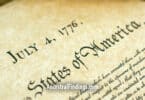When we think of the Secret Service today, we picture stoic agents in dark suits, earpieces in place, and eyes ever-vigilant, guarding the President and other key figures. Yet, the Secret Service’s origins are rooted in a different mission: combatting counterfeit currency. This unique dual role—protection and investigation—defines the agency’s significant place in American history.
The Birth of the Secret Service
The Secret Service was born out of necessity on July 5, 1865, in the chaotic aftermath of the Civil War. At the time, counterfeit money was rampant, threatening to destabilize the already fragile post-war economy. Nearly one-third of the currency in circulation was fake, causing widespread economic uncertainty. To combat this, President Abraham Lincoln established the Secret Service, initially as a branch of the Department of the Treasury, to tackle this counterfeit epidemic.
Abraham Lincoln’s foresight in establishing the Secret Service was tragically underscored by his assassination, which happened the very night he signed the legislation authorizing its creation. John Wilkes Booth’s fatal shot highlighted the vulnerability of the nation’s leaders and foreshadowed the protective role the Secret Service would later assume.
Key Figures in the Early Days
The first head of the Secret Service was William P. Wood, appointed in 1865. Wood, a former Union Army officer and warden of the Old Capitol Prison was tasked with assembling and leading a team to crack down on counterfeiters. Under his leadership, the Secret Service made significant strides in restoring confidence in the nation’s currency by infiltrating and dismantling numerous counterfeiting operations.
Expanding Responsibilities and Protective Role
Initially focused solely on safeguarding the nation’s financial system, the Secret Service’s mission expanded as the nation’s needs evolved. The assassination of President William McKinley in 1901 was a pivotal moment that led Congress to request the Secret Service to provide full-time protection to the President, a role that became permanent in 1902. This marked the beginning of the agency’s protective mission, which has since become one of its most recognized functions.
The Protective Mission
The Secret Service’s protective mission encompasses not just the President but also the Vice President, their immediate families, visiting foreign dignitaries, and other key figures. This role requires a delicate balance of being visible enough to deter threats while remaining unobtrusive to allow those they protect to maintain a sense of normalcy.
One of the most significant challenges the Secret Service faces is this balance, illustrated starkly during President John F. Kennedy’s assassination in 1963. This tragic event led to profound changes in the agency’s procedures, such as the introduction of more advanced protective measures and the reorganization of how protective details are managed.
High-Profile Cases and Innovations
Throughout its history, the Secret Service has been involved in numerous high-profile cases that have tested its capabilities. From foiling assassination attempts to investigating complex financial crimes, the agency’s work is marked by moments of critical importance and intense drama.
One notable incident was the attempted assassination of President Harry S. Truman in 1950 by Puerto Rican nationalists. The attackers struck at Blair House, where Truman was residing during White House renovations, leading to a deadly shootout. This event underscored the constant dangers faced by agents and the importance of their training and readiness.
Technological innovation has always been central to the Secret Service’s approach. From the early days of using basic forensic methods to the sophisticated digital forensics employed today, the agency continually evolves to meet the demands of its dual mission. The introduction of the Counter Assault Team (CAT) in the 1970s, for example, provided an additional layer of protection for high-risk situations.
The Secret Service Today
Today, the Secret Service operates under the Department of Homeland Security, having been transferred from the Department of the Treasury in 2003 as part of the reorganization following the 9/11 terrorist attacks. This move highlighted the interconnected nature of modern security threats.
The agency’s mission now extends beyond physical protection to include cybersecurity. With the rise of digital threats, the Secret Service’s National Computer Forensics Institute trains law enforcement officers, prosecutors, and judges in cybercrime investigations, equipping them to handle the complexities of the digital age.
A Legacy of Dedication
The Secret Service’s history is a testament to its adaptability and dedication. From fighting counterfeiters in its early days to protecting national leaders and financial systems today, the agency has continually evolved to meet the changing needs of the nation.
One of the most remarkable aspects of the Secret Service is the dedication and bravery of its agents. These individuals undergo rigorous training and face considerable risks daily, all in the service of their country. Their stories, often untold and unseen, are powerful reminders of the sacrifices made to ensure the safety and security of the United States.
Conclusion
The United States Secret Service is much more than the iconic image of agents in dark suits. It is an institution with a rich history, marked by a commitment to protecting both the nation’s leaders and its financial integrity. As it continues to evolve in response to new challenges, the Secret Service remains a vital part of America’s security framework, embodying the values of dedication, adaptability, and vigilance.
So, the next time you see those familiar figures standing watch, remember the remarkable journey that brought the Secret Service to where it is today—a journey that continues, always adapting to safeguard the nation’s future.
These books will give readers a deeper understanding of the Secret Service’s history, from its inception to its current role in national security.
This book provides an insider’s view of the Secret Service, highlighting its historical evolution and current challenges.
“Zero Fail: The Rise and Fall of the Secret Service” by Carol Leonnig
A comprehensive account detailing the Secret Service’s journey from the Kennedy assassination to modern-day controversies and challenges.
It is an engaging memoir by a former agent who played a crucial role during the Reagan assassination attempt, providing insights into the agency’s operations.
This book offers a behind-the-scenes look at the Secret Service, revealing stories of agents and their experiences with various presidents.
“The Secret Service: The Hidden History of an Enigmatic Agency” by Philip H. Melanson
A thorough examination of the Secret Service’s history, focusing on its protective and investigative missions.






